Leadership & Management: Application of Approaches in Starbucks
VerifiedAdded on 2021/01/02
|13
|4343
|159
Report
AI Summary
This report delves into the application of management and operational approaches within an organizational context, using Starbucks as a case study. It begins by defining and contrasting the roles and characteristics of leaders and managers, emphasizing the importance of strategic execution, vision creation, direction, and monitoring. The report then explores how leadership and management functions differ across various situational contexts, such as fast-changing, moderately changing, and stable situations, and how different leadership theories, including situational, system, and contingency leadership, can be applied. Furthermore, it examines key approaches to operations management, like Total Quality Management, and highlights the roles of leaders and managers in ensuring operational efficiency and quality improvement. The report also discusses the importance of supply chain management, lean management, and the role of managers in employee motivation and development, offering a comprehensive analysis of leadership and management practices within a contemporary business environment.
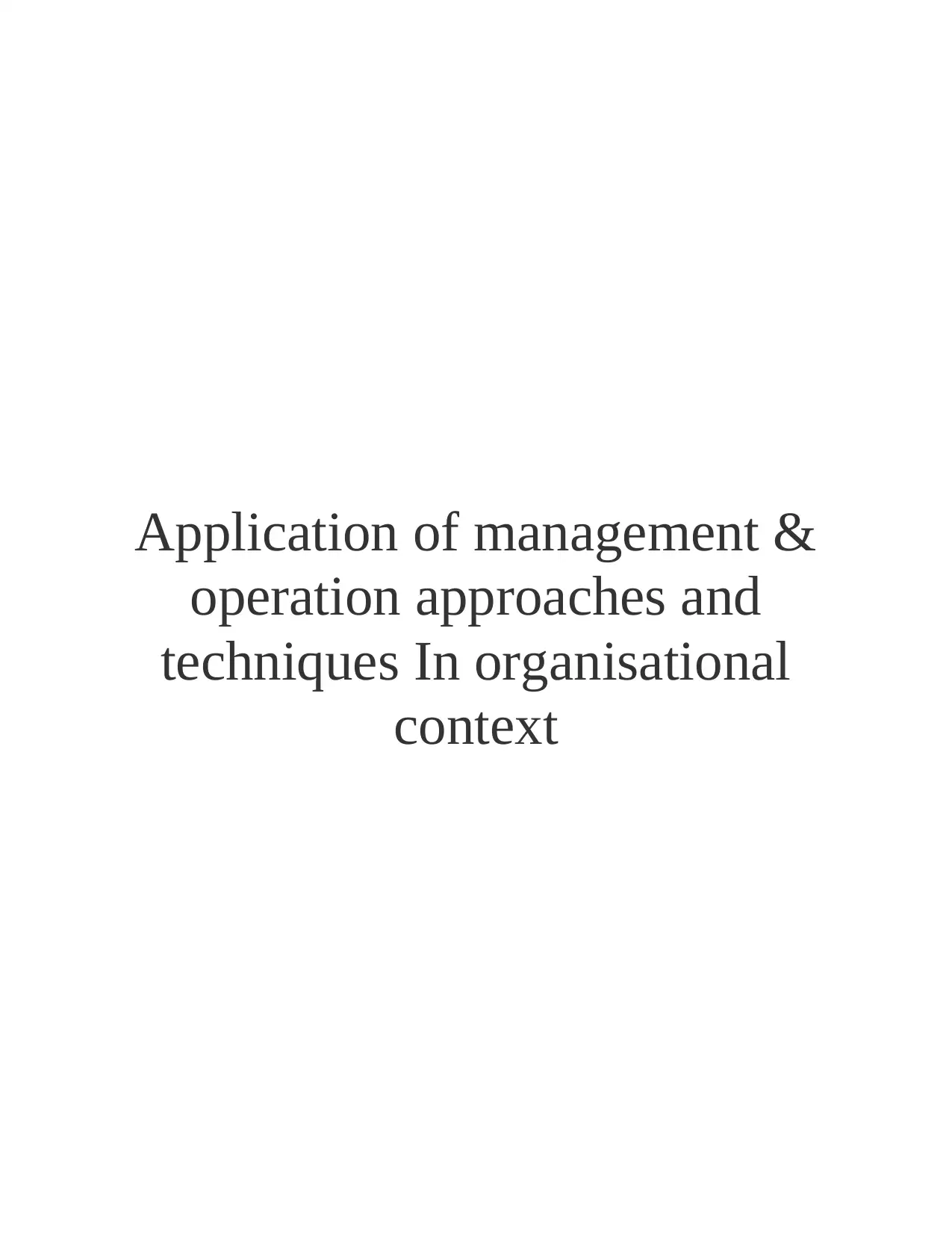
Application of management &
operation approaches and
techniques In organisational
context
operation approaches and
techniques In organisational
context
Paraphrase This Document
Need a fresh take? Get an instant paraphrase of this document with our AI Paraphraser
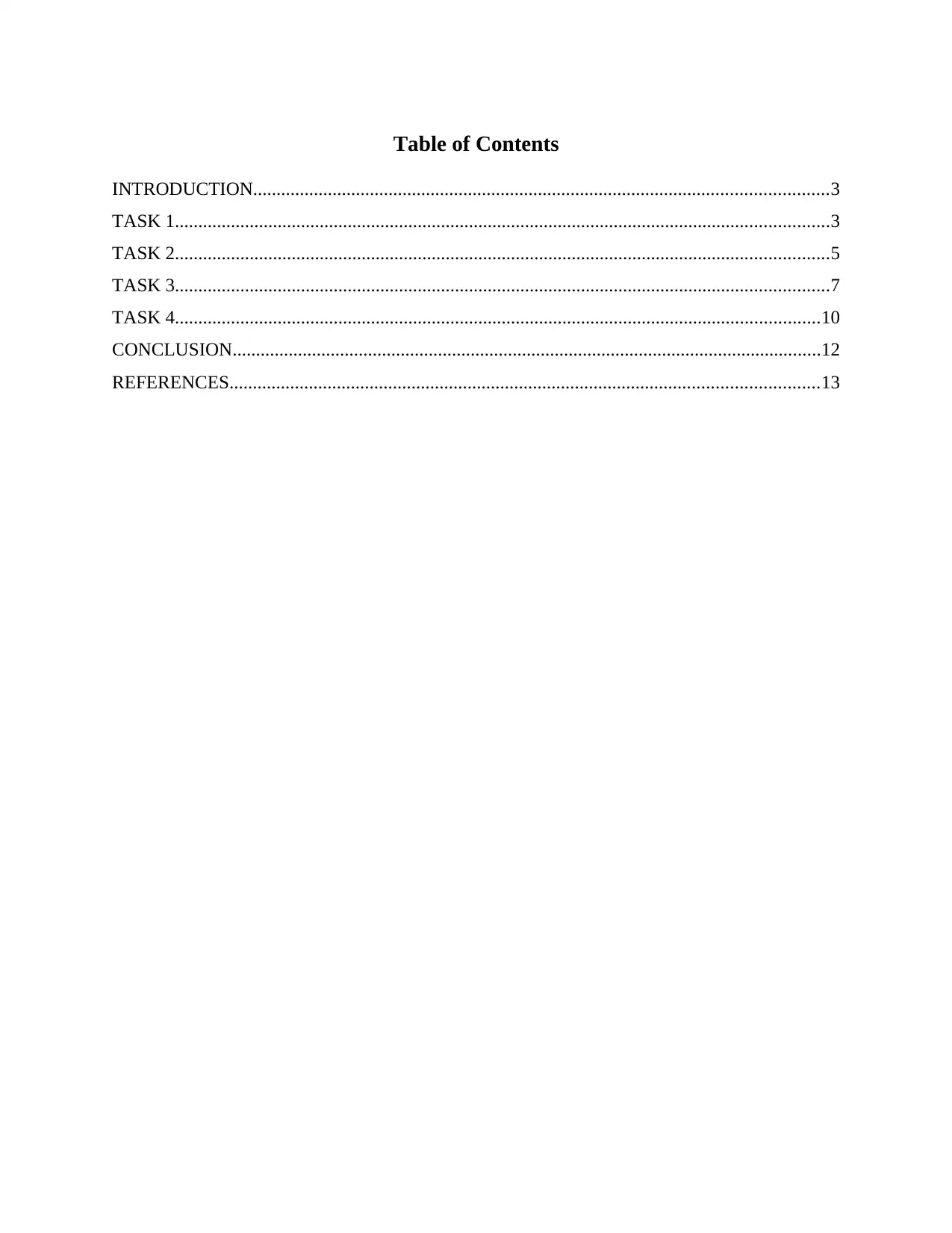
Table of Contents
INTRODUCTION...........................................................................................................................3
TASK 1............................................................................................................................................3
TASK 2............................................................................................................................................5
TASK 3............................................................................................................................................7
TASK 4..........................................................................................................................................10
CONCLUSION..............................................................................................................................12
REFERENCES..............................................................................................................................13
INTRODUCTION...........................................................................................................................3
TASK 1............................................................................................................................................3
TASK 2............................................................................................................................................5
TASK 3............................................................................................................................................7
TASK 4..........................................................................................................................................10
CONCLUSION..............................................................................................................................12
REFERENCES..............................................................................................................................13
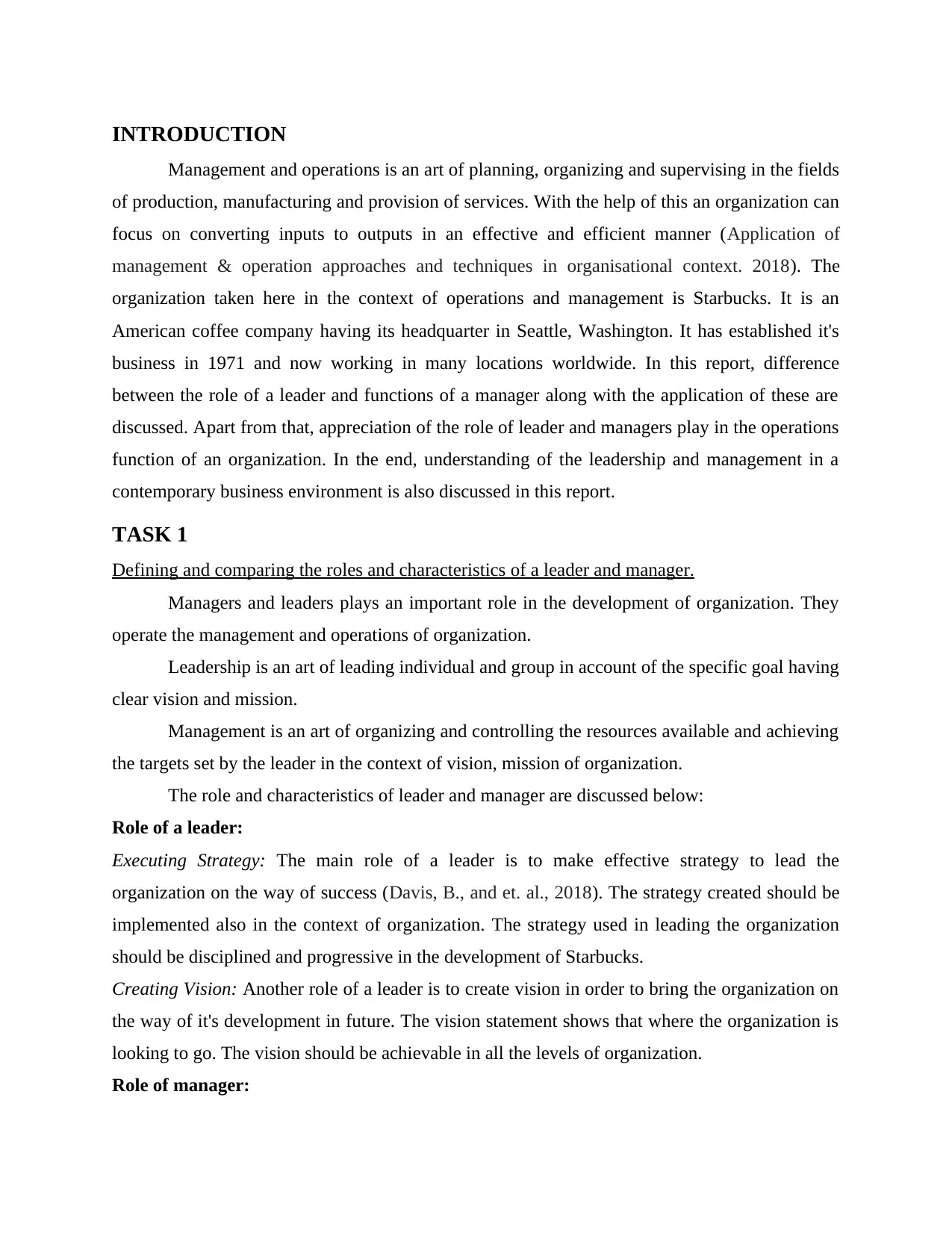
INTRODUCTION
Management and operations is an art of planning, organizing and supervising in the fields
of production, manufacturing and provision of services. With the help of this an organization can
focus on converting inputs to outputs in an effective and efficient manner (Application of
management & operation approaches and techniques in organisational context. 2018). The
organization taken here in the context of operations and management is Starbucks. It is an
American coffee company having its headquarter in Seattle, Washington. It has established it's
business in 1971 and now working in many locations worldwide. In this report, difference
between the role of a leader and functions of a manager along with the application of these are
discussed. Apart from that, appreciation of the role of leader and managers play in the operations
function of an organization. In the end, understanding of the leadership and management in a
contemporary business environment is also discussed in this report.
TASK 1
Defining and comparing the roles and characteristics of a leader and manager.
Managers and leaders plays an important role in the development of organization. They
operate the management and operations of organization.
Leadership is an art of leading individual and group in account of the specific goal having
clear vision and mission.
Management is an art of organizing and controlling the resources available and achieving
the targets set by the leader in the context of vision, mission of organization.
The role and characteristics of leader and manager are discussed below:
Role of a leader:
Executing Strategy: The main role of a leader is to make effective strategy to lead the
organization on the way of success (Davis, B., and et. al., 2018). The strategy created should be
implemented also in the context of organization. The strategy used in leading the organization
should be disciplined and progressive in the development of Starbucks.
Creating Vision: Another role of a leader is to create vision in order to bring the organization on
the way of it's development in future. The vision statement shows that where the organization is
looking to go. The vision should be achievable in all the levels of organization.
Role of manager:
Management and operations is an art of planning, organizing and supervising in the fields
of production, manufacturing and provision of services. With the help of this an organization can
focus on converting inputs to outputs in an effective and efficient manner (Application of
management & operation approaches and techniques in organisational context. 2018). The
organization taken here in the context of operations and management is Starbucks. It is an
American coffee company having its headquarter in Seattle, Washington. It has established it's
business in 1971 and now working in many locations worldwide. In this report, difference
between the role of a leader and functions of a manager along with the application of these are
discussed. Apart from that, appreciation of the role of leader and managers play in the operations
function of an organization. In the end, understanding of the leadership and management in a
contemporary business environment is also discussed in this report.
TASK 1
Defining and comparing the roles and characteristics of a leader and manager.
Managers and leaders plays an important role in the development of organization. They
operate the management and operations of organization.
Leadership is an art of leading individual and group in account of the specific goal having
clear vision and mission.
Management is an art of organizing and controlling the resources available and achieving
the targets set by the leader in the context of vision, mission of organization.
The role and characteristics of leader and manager are discussed below:
Role of a leader:
Executing Strategy: The main role of a leader is to make effective strategy to lead the
organization on the way of success (Davis, B., and et. al., 2018). The strategy created should be
implemented also in the context of organization. The strategy used in leading the organization
should be disciplined and progressive in the development of Starbucks.
Creating Vision: Another role of a leader is to create vision in order to bring the organization on
the way of it's development in future. The vision statement shows that where the organization is
looking to go. The vision should be achievable in all the levels of organization.
Role of manager:
⊘ This is a preview!⊘
Do you want full access?
Subscribe today to unlock all pages.

Trusted by 1+ million students worldwide
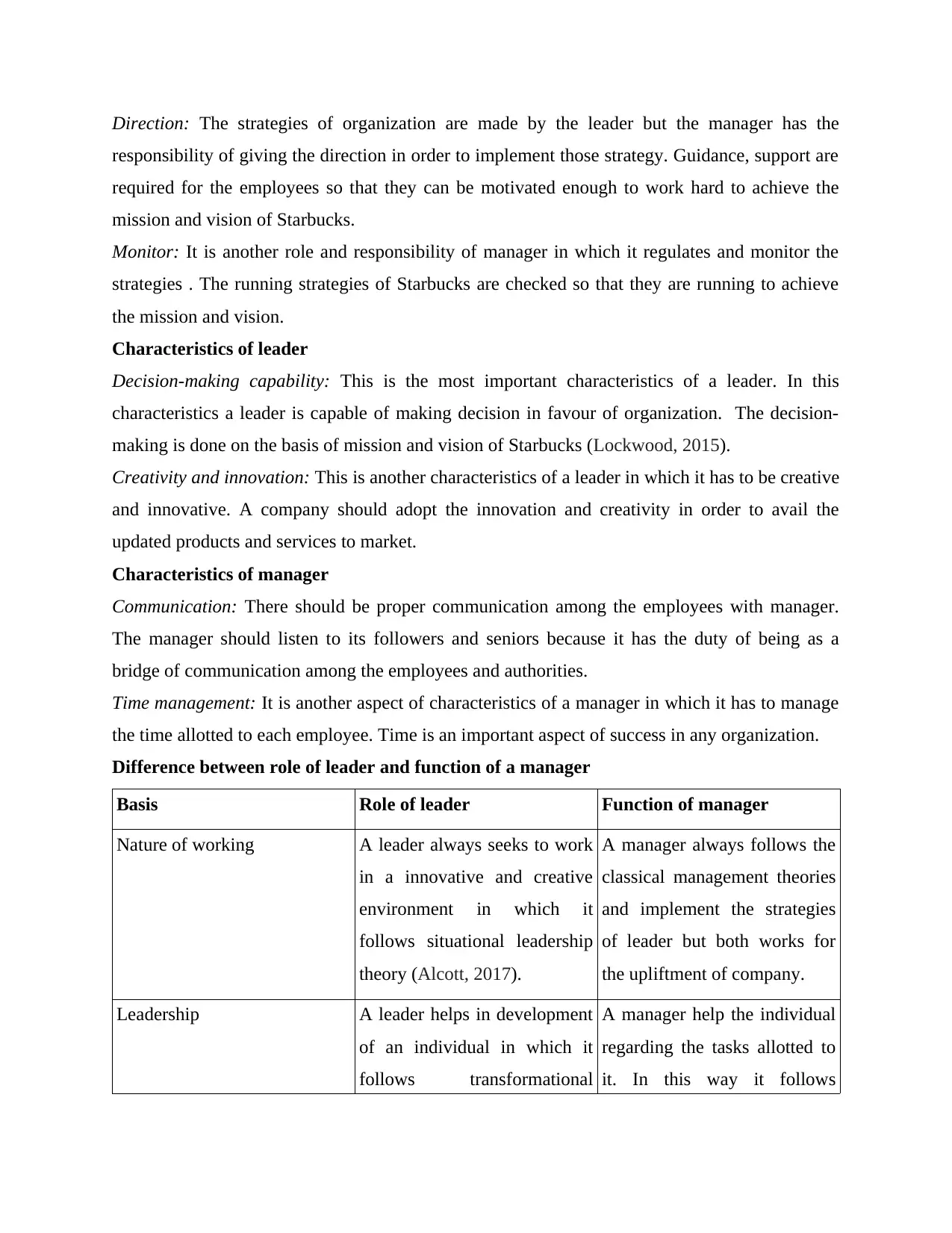
Direction: The strategies of organization are made by the leader but the manager has the
responsibility of giving the direction in order to implement those strategy. Guidance, support are
required for the employees so that they can be motivated enough to work hard to achieve the
mission and vision of Starbucks.
Monitor: It is another role and responsibility of manager in which it regulates and monitor the
strategies . The running strategies of Starbucks are checked so that they are running to achieve
the mission and vision.
Characteristics of leader
Decision-making capability: This is the most important characteristics of a leader. In this
characteristics a leader is capable of making decision in favour of organization. The decision-
making is done on the basis of mission and vision of Starbucks (Lockwood, 2015).
Creativity and innovation: This is another characteristics of a leader in which it has to be creative
and innovative. A company should adopt the innovation and creativity in order to avail the
updated products and services to market.
Characteristics of manager
Communication: There should be proper communication among the employees with manager.
The manager should listen to its followers and seniors because it has the duty of being as a
bridge of communication among the employees and authorities.
Time management: It is another aspect of characteristics of a manager in which it has to manage
the time allotted to each employee. Time is an important aspect of success in any organization.
Difference between role of leader and function of a manager
Basis Role of leader Function of manager
Nature of working A leader always seeks to work
in a innovative and creative
environment in which it
follows situational leadership
theory (Alcott, 2017).
A manager always follows the
classical management theories
and implement the strategies
of leader but both works for
the upliftment of company.
Leadership A leader helps in development
of an individual in which it
follows transformational
A manager help the individual
regarding the tasks allotted to
it. In this way it follows
responsibility of giving the direction in order to implement those strategy. Guidance, support are
required for the employees so that they can be motivated enough to work hard to achieve the
mission and vision of Starbucks.
Monitor: It is another role and responsibility of manager in which it regulates and monitor the
strategies . The running strategies of Starbucks are checked so that they are running to achieve
the mission and vision.
Characteristics of leader
Decision-making capability: This is the most important characteristics of a leader. In this
characteristics a leader is capable of making decision in favour of organization. The decision-
making is done on the basis of mission and vision of Starbucks (Lockwood, 2015).
Creativity and innovation: This is another characteristics of a leader in which it has to be creative
and innovative. A company should adopt the innovation and creativity in order to avail the
updated products and services to market.
Characteristics of manager
Communication: There should be proper communication among the employees with manager.
The manager should listen to its followers and seniors because it has the duty of being as a
bridge of communication among the employees and authorities.
Time management: It is another aspect of characteristics of a manager in which it has to manage
the time allotted to each employee. Time is an important aspect of success in any organization.
Difference between role of leader and function of a manager
Basis Role of leader Function of manager
Nature of working A leader always seeks to work
in a innovative and creative
environment in which it
follows situational leadership
theory (Alcott, 2017).
A manager always follows the
classical management theories
and implement the strategies
of leader but both works for
the upliftment of company.
Leadership A leader helps in development
of an individual in which it
follows transformational
A manager help the individual
regarding the tasks allotted to
it. In this way it follows
Paraphrase This Document
Need a fresh take? Get an instant paraphrase of this document with our AI Paraphraser
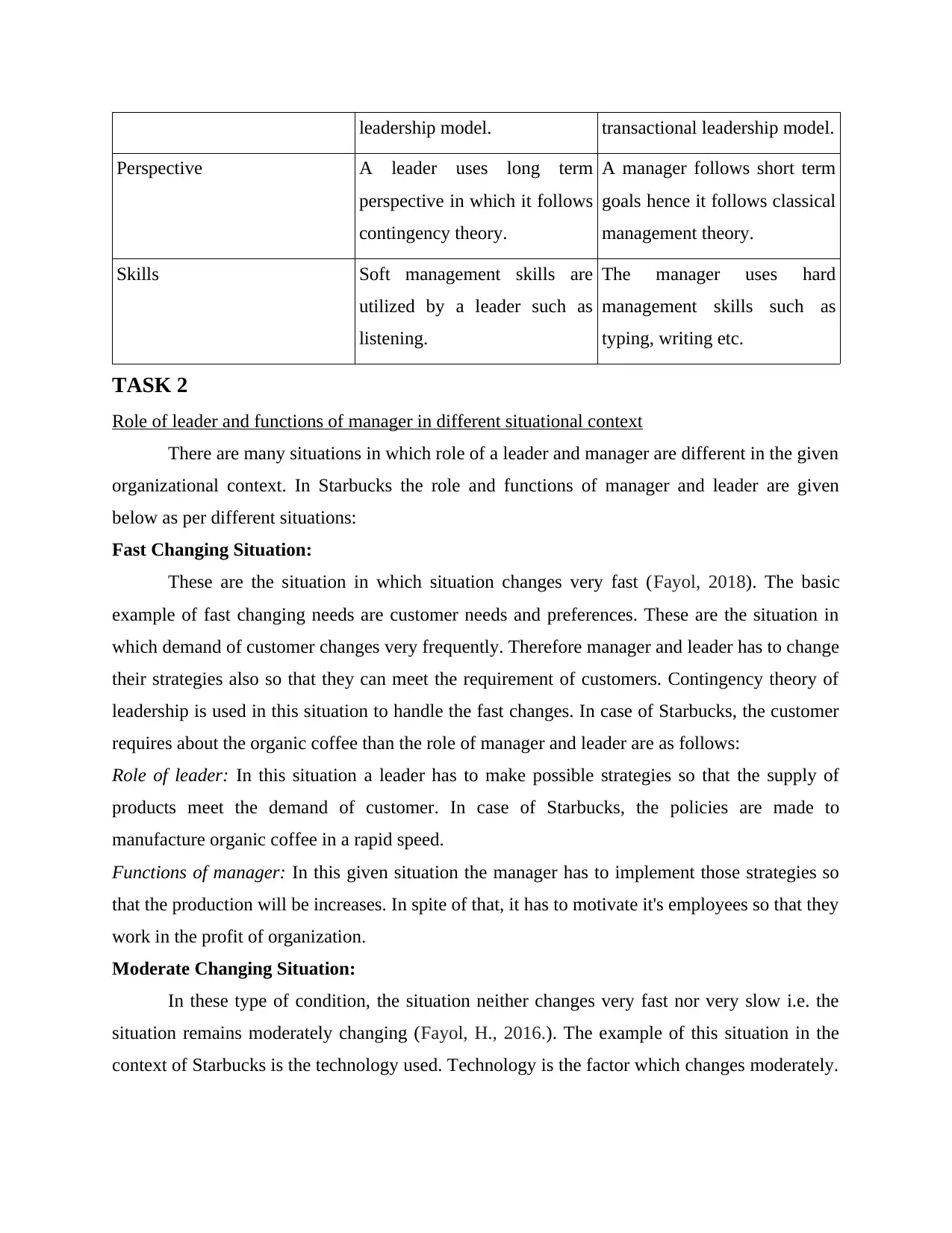
leadership model. transactional leadership model.
Perspective A leader uses long term
perspective in which it follows
contingency theory.
A manager follows short term
goals hence it follows classical
management theory.
Skills Soft management skills are
utilized by a leader such as
listening.
The manager uses hard
management skills such as
typing, writing etc.
TASK 2
Role of leader and functions of manager in different situational context
There are many situations in which role of a leader and manager are different in the given
organizational context. In Starbucks the role and functions of manager and leader are given
below as per different situations:
Fast Changing Situation:
These are the situation in which situation changes very fast (Fayol, 2018). The basic
example of fast changing needs are customer needs and preferences. These are the situation in
which demand of customer changes very frequently. Therefore manager and leader has to change
their strategies also so that they can meet the requirement of customers. Contingency theory of
leadership is used in this situation to handle the fast changes. In case of Starbucks, the customer
requires about the organic coffee than the role of manager and leader are as follows:
Role of leader: In this situation a leader has to make possible strategies so that the supply of
products meet the demand of customer. In case of Starbucks, the policies are made to
manufacture organic coffee in a rapid speed.
Functions of manager: In this given situation the manager has to implement those strategies so
that the production will be increases. In spite of that, it has to motivate it's employees so that they
work in the profit of organization.
Moderate Changing Situation:
In these type of condition, the situation neither changes very fast nor very slow i.e. the
situation remains moderately changing (Fayol, H., 2016.). The example of this situation in the
context of Starbucks is the technology used. Technology is the factor which changes moderately.
Perspective A leader uses long term
perspective in which it follows
contingency theory.
A manager follows short term
goals hence it follows classical
management theory.
Skills Soft management skills are
utilized by a leader such as
listening.
The manager uses hard
management skills such as
typing, writing etc.
TASK 2
Role of leader and functions of manager in different situational context
There are many situations in which role of a leader and manager are different in the given
organizational context. In Starbucks the role and functions of manager and leader are given
below as per different situations:
Fast Changing Situation:
These are the situation in which situation changes very fast (Fayol, 2018). The basic
example of fast changing needs are customer needs and preferences. These are the situation in
which demand of customer changes very frequently. Therefore manager and leader has to change
their strategies also so that they can meet the requirement of customers. Contingency theory of
leadership is used in this situation to handle the fast changes. In case of Starbucks, the customer
requires about the organic coffee than the role of manager and leader are as follows:
Role of leader: In this situation a leader has to make possible strategies so that the supply of
products meet the demand of customer. In case of Starbucks, the policies are made to
manufacture organic coffee in a rapid speed.
Functions of manager: In this given situation the manager has to implement those strategies so
that the production will be increases. In spite of that, it has to motivate it's employees so that they
work in the profit of organization.
Moderate Changing Situation:
In these type of condition, the situation neither changes very fast nor very slow i.e. the
situation remains moderately changing (Fayol, H., 2016.). The example of this situation in the
context of Starbucks is the technology used. Technology is the factor which changes moderately.
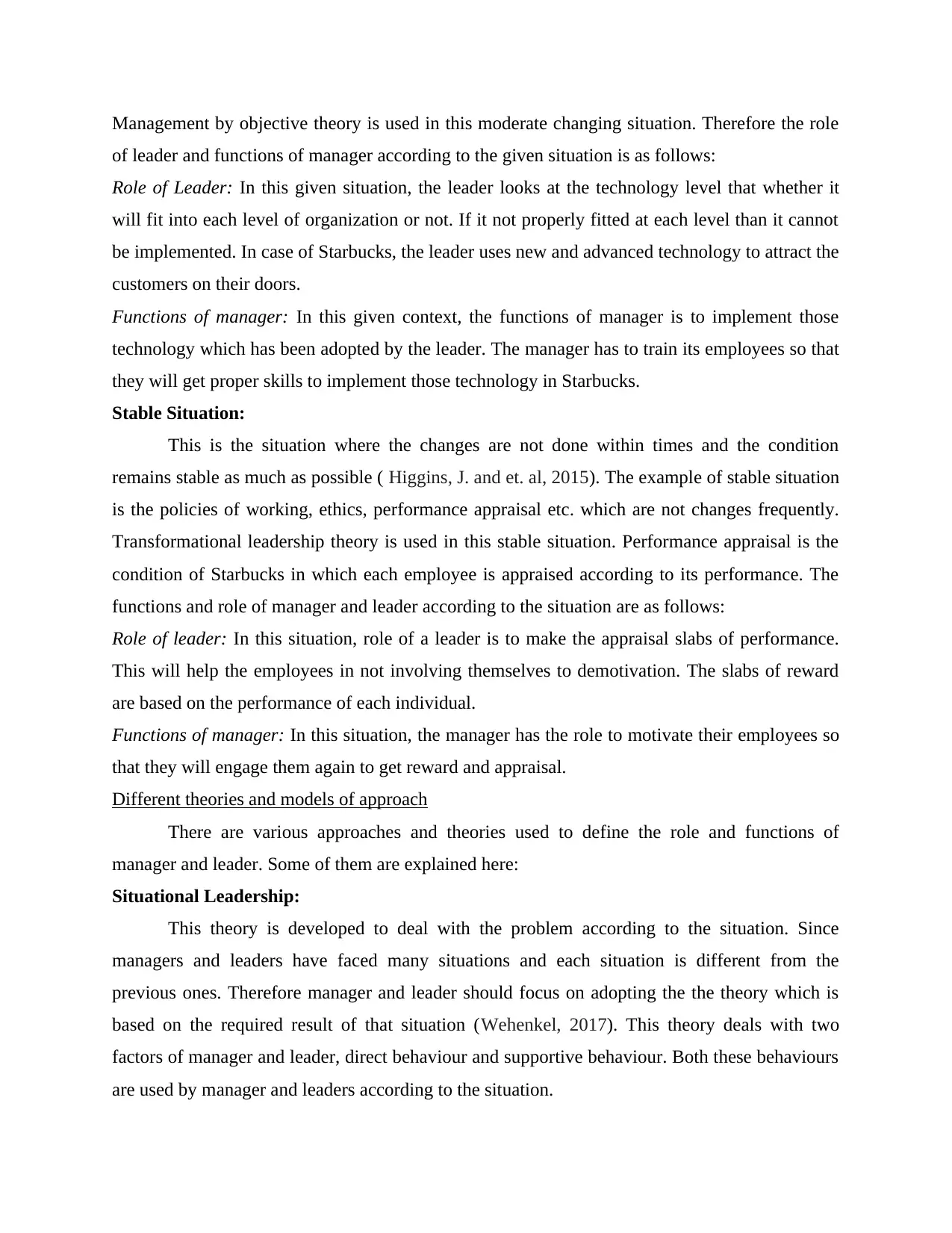
Management by objective theory is used in this moderate changing situation. Therefore the role
of leader and functions of manager according to the given situation is as follows:
Role of Leader: In this given situation, the leader looks at the technology level that whether it
will fit into each level of organization or not. If it not properly fitted at each level than it cannot
be implemented. In case of Starbucks, the leader uses new and advanced technology to attract the
customers on their doors.
Functions of manager: In this given context, the functions of manager is to implement those
technology which has been adopted by the leader. The manager has to train its employees so that
they will get proper skills to implement those technology in Starbucks.
Stable Situation:
This is the situation where the changes are not done within times and the condition
remains stable as much as possible ( Higgins, J. and et. al, 2015). The example of stable situation
is the policies of working, ethics, performance appraisal etc. which are not changes frequently.
Transformational leadership theory is used in this stable situation. Performance appraisal is the
condition of Starbucks in which each employee is appraised according to its performance. The
functions and role of manager and leader according to the situation are as follows:
Role of leader: In this situation, role of a leader is to make the appraisal slabs of performance.
This will help the employees in not involving themselves to demotivation. The slabs of reward
are based on the performance of each individual.
Functions of manager: In this situation, the manager has the role to motivate their employees so
that they will engage them again to get reward and appraisal.
Different theories and models of approach
There are various approaches and theories used to define the role and functions of
manager and leader. Some of them are explained here:
Situational Leadership:
This theory is developed to deal with the problem according to the situation. Since
managers and leaders have faced many situations and each situation is different from the
previous ones. Therefore manager and leader should focus on adopting the the theory which is
based on the required result of that situation (Wehenkel, 2017). This theory deals with two
factors of manager and leader, direct behaviour and supportive behaviour. Both these behaviours
are used by manager and leaders according to the situation.
of leader and functions of manager according to the given situation is as follows:
Role of Leader: In this given situation, the leader looks at the technology level that whether it
will fit into each level of organization or not. If it not properly fitted at each level than it cannot
be implemented. In case of Starbucks, the leader uses new and advanced technology to attract the
customers on their doors.
Functions of manager: In this given context, the functions of manager is to implement those
technology which has been adopted by the leader. The manager has to train its employees so that
they will get proper skills to implement those technology in Starbucks.
Stable Situation:
This is the situation where the changes are not done within times and the condition
remains stable as much as possible ( Higgins, J. and et. al, 2015). The example of stable situation
is the policies of working, ethics, performance appraisal etc. which are not changes frequently.
Transformational leadership theory is used in this stable situation. Performance appraisal is the
condition of Starbucks in which each employee is appraised according to its performance. The
functions and role of manager and leader according to the situation are as follows:
Role of leader: In this situation, role of a leader is to make the appraisal slabs of performance.
This will help the employees in not involving themselves to demotivation. The slabs of reward
are based on the performance of each individual.
Functions of manager: In this situation, the manager has the role to motivate their employees so
that they will engage them again to get reward and appraisal.
Different theories and models of approach
There are various approaches and theories used to define the role and functions of
manager and leader. Some of them are explained here:
Situational Leadership:
This theory is developed to deal with the problem according to the situation. Since
managers and leaders have faced many situations and each situation is different from the
previous ones. Therefore manager and leader should focus on adopting the the theory which is
based on the required result of that situation (Wehenkel, 2017). This theory deals with two
factors of manager and leader, direct behaviour and supportive behaviour. Both these behaviours
are used by manager and leaders according to the situation.
⊘ This is a preview!⊘
Do you want full access?
Subscribe today to unlock all pages.

Trusted by 1+ million students worldwide
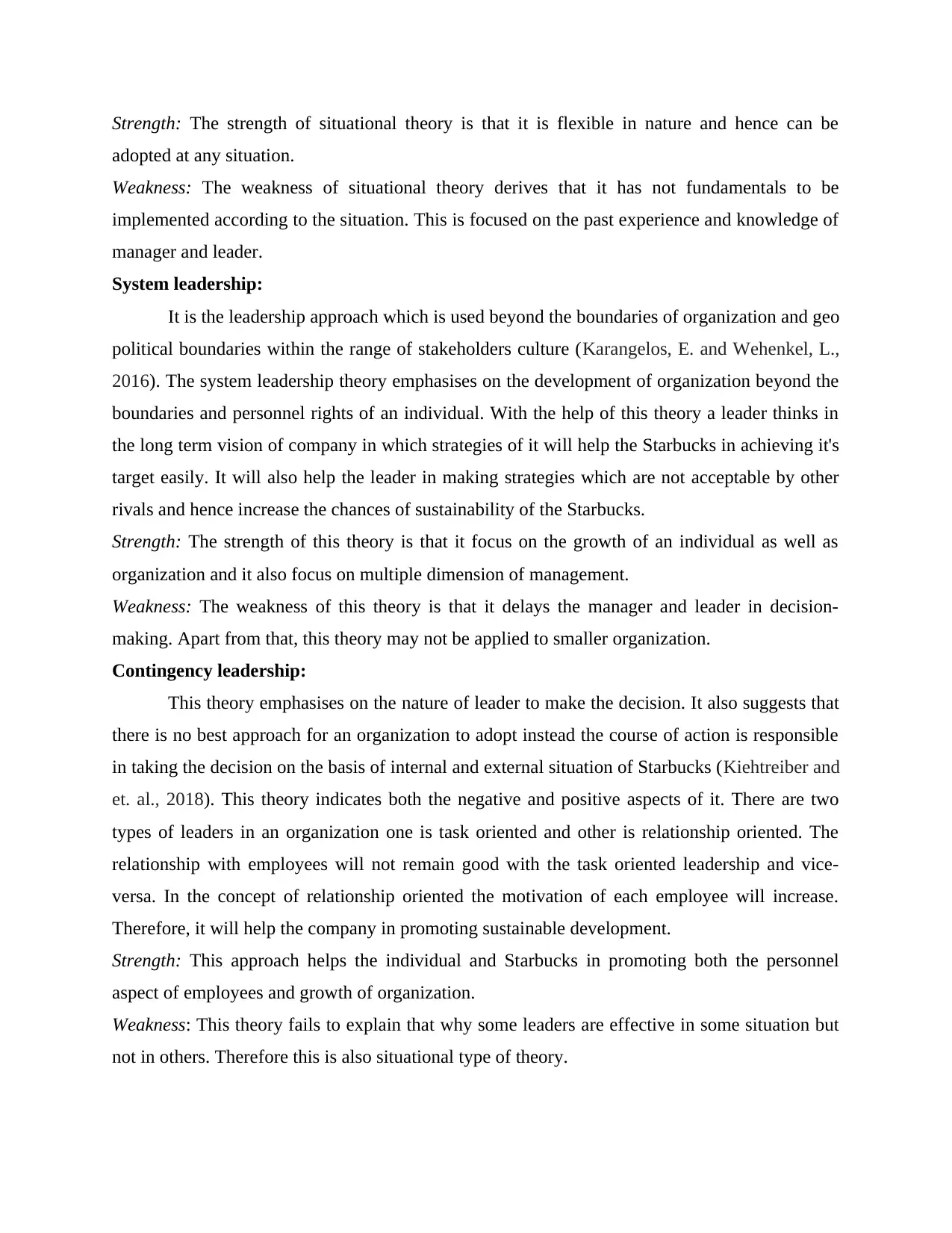
Strength: The strength of situational theory is that it is flexible in nature and hence can be
adopted at any situation.
Weakness: The weakness of situational theory derives that it has not fundamentals to be
implemented according to the situation. This is focused on the past experience and knowledge of
manager and leader.
System leadership:
It is the leadership approach which is used beyond the boundaries of organization and geo
political boundaries within the range of stakeholders culture (Karangelos, E. and Wehenkel, L.,
2016). The system leadership theory emphasises on the development of organization beyond the
boundaries and personnel rights of an individual. With the help of this theory a leader thinks in
the long term vision of company in which strategies of it will help the Starbucks in achieving it's
target easily. It will also help the leader in making strategies which are not acceptable by other
rivals and hence increase the chances of sustainability of the Starbucks.
Strength: The strength of this theory is that it focus on the growth of an individual as well as
organization and it also focus on multiple dimension of management.
Weakness: The weakness of this theory is that it delays the manager and leader in decision-
making. Apart from that, this theory may not be applied to smaller organization.
Contingency leadership:
This theory emphasises on the nature of leader to make the decision. It also suggests that
there is no best approach for an organization to adopt instead the course of action is responsible
in taking the decision on the basis of internal and external situation of Starbucks (Kiehtreiber and
et. al., 2018). This theory indicates both the negative and positive aspects of it. There are two
types of leaders in an organization one is task oriented and other is relationship oriented. The
relationship with employees will not remain good with the task oriented leadership and vice-
versa. In the concept of relationship oriented the motivation of each employee will increase.
Therefore, it will help the company in promoting sustainable development.
Strength: This approach helps the individual and Starbucks in promoting both the personnel
aspect of employees and growth of organization.
Weakness: This theory fails to explain that why some leaders are effective in some situation but
not in others. Therefore this is also situational type of theory.
adopted at any situation.
Weakness: The weakness of situational theory derives that it has not fundamentals to be
implemented according to the situation. This is focused on the past experience and knowledge of
manager and leader.
System leadership:
It is the leadership approach which is used beyond the boundaries of organization and geo
political boundaries within the range of stakeholders culture (Karangelos, E. and Wehenkel, L.,
2016). The system leadership theory emphasises on the development of organization beyond the
boundaries and personnel rights of an individual. With the help of this theory a leader thinks in
the long term vision of company in which strategies of it will help the Starbucks in achieving it's
target easily. It will also help the leader in making strategies which are not acceptable by other
rivals and hence increase the chances of sustainability of the Starbucks.
Strength: The strength of this theory is that it focus on the growth of an individual as well as
organization and it also focus on multiple dimension of management.
Weakness: The weakness of this theory is that it delays the manager and leader in decision-
making. Apart from that, this theory may not be applied to smaller organization.
Contingency leadership:
This theory emphasises on the nature of leader to make the decision. It also suggests that
there is no best approach for an organization to adopt instead the course of action is responsible
in taking the decision on the basis of internal and external situation of Starbucks (Kiehtreiber and
et. al., 2018). This theory indicates both the negative and positive aspects of it. There are two
types of leaders in an organization one is task oriented and other is relationship oriented. The
relationship with employees will not remain good with the task oriented leadership and vice-
versa. In the concept of relationship oriented the motivation of each employee will increase.
Therefore, it will help the company in promoting sustainable development.
Strength: This approach helps the individual and Starbucks in promoting both the personnel
aspect of employees and growth of organization.
Weakness: This theory fails to explain that why some leaders are effective in some situation but
not in others. Therefore this is also situational type of theory.
Paraphrase This Document
Need a fresh take? Get an instant paraphrase of this document with our AI Paraphraser
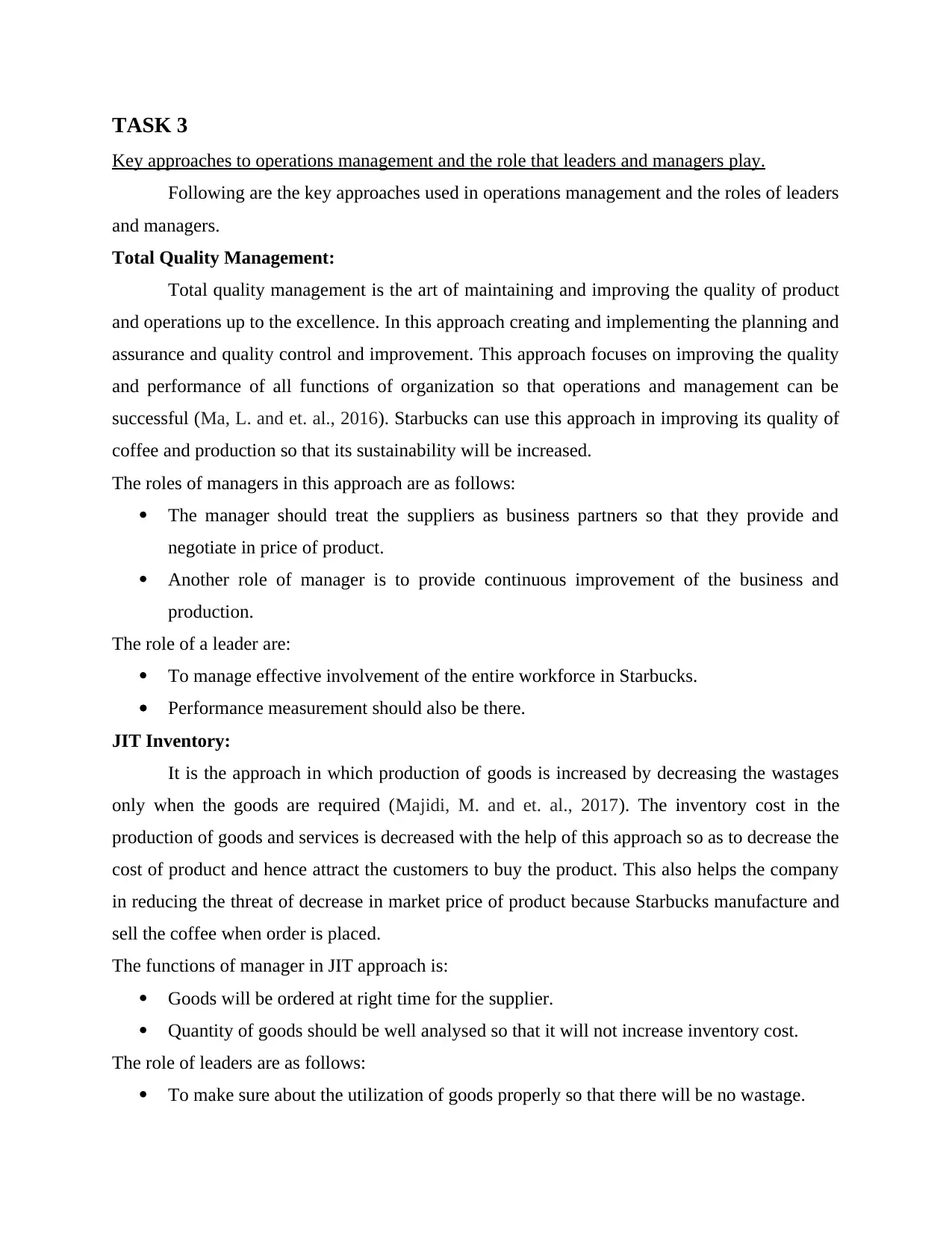
TASK 3
Key approaches to operations management and the role that leaders and managers play.
Following are the key approaches used in operations management and the roles of leaders
and managers.
Total Quality Management:
Total quality management is the art of maintaining and improving the quality of product
and operations up to the excellence. In this approach creating and implementing the planning and
assurance and quality control and improvement. This approach focuses on improving the quality
and performance of all functions of organization so that operations and management can be
successful (Ma, L. and et. al., 2016). Starbucks can use this approach in improving its quality of
coffee and production so that its sustainability will be increased.
The roles of managers in this approach are as follows:
The manager should treat the suppliers as business partners so that they provide and
negotiate in price of product.
Another role of manager is to provide continuous improvement of the business and
production.
The role of a leader are:
To manage effective involvement of the entire workforce in Starbucks.
Performance measurement should also be there.
JIT Inventory:
It is the approach in which production of goods is increased by decreasing the wastages
only when the goods are required (Majidi, M. and et. al., 2017). The inventory cost in the
production of goods and services is decreased with the help of this approach so as to decrease the
cost of product and hence attract the customers to buy the product. This also helps the company
in reducing the threat of decrease in market price of product because Starbucks manufacture and
sell the coffee when order is placed.
The functions of manager in JIT approach is:
Goods will be ordered at right time for the supplier.
Quantity of goods should be well analysed so that it will not increase inventory cost.
The role of leaders are as follows:
To make sure about the utilization of goods properly so that there will be no wastage.
Key approaches to operations management and the role that leaders and managers play.
Following are the key approaches used in operations management and the roles of leaders
and managers.
Total Quality Management:
Total quality management is the art of maintaining and improving the quality of product
and operations up to the excellence. In this approach creating and implementing the planning and
assurance and quality control and improvement. This approach focuses on improving the quality
and performance of all functions of organization so that operations and management can be
successful (Ma, L. and et. al., 2016). Starbucks can use this approach in improving its quality of
coffee and production so that its sustainability will be increased.
The roles of managers in this approach are as follows:
The manager should treat the suppliers as business partners so that they provide and
negotiate in price of product.
Another role of manager is to provide continuous improvement of the business and
production.
The role of a leader are:
To manage effective involvement of the entire workforce in Starbucks.
Performance measurement should also be there.
JIT Inventory:
It is the approach in which production of goods is increased by decreasing the wastages
only when the goods are required (Majidi, M. and et. al., 2017). The inventory cost in the
production of goods and services is decreased with the help of this approach so as to decrease the
cost of product and hence attract the customers to buy the product. This also helps the company
in reducing the threat of decrease in market price of product because Starbucks manufacture and
sell the coffee when order is placed.
The functions of manager in JIT approach is:
Goods will be ordered at right time for the supplier.
Quantity of goods should be well analysed so that it will not increase inventory cost.
The role of leaders are as follows:
To make sure about the utilization of goods properly so that there will be no wastage.
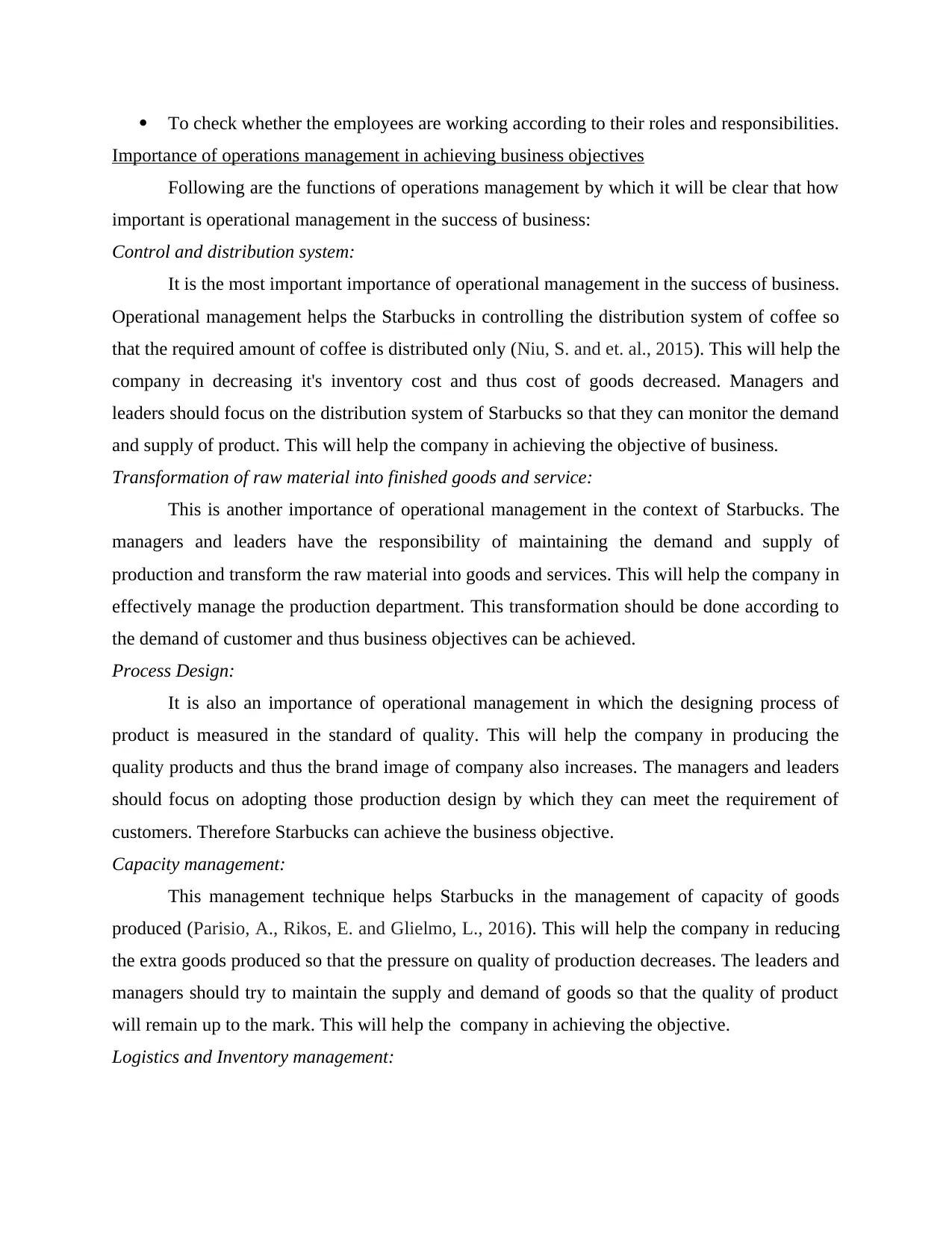
To check whether the employees are working according to their roles and responsibilities.
Importance of operations management in achieving business objectives
Following are the functions of operations management by which it will be clear that how
important is operational management in the success of business:
Control and distribution system:
It is the most important importance of operational management in the success of business.
Operational management helps the Starbucks in controlling the distribution system of coffee so
that the required amount of coffee is distributed only (Niu, S. and et. al., 2015). This will help the
company in decreasing it's inventory cost and thus cost of goods decreased. Managers and
leaders should focus on the distribution system of Starbucks so that they can monitor the demand
and supply of product. This will help the company in achieving the objective of business.
Transformation of raw material into finished goods and service:
This is another importance of operational management in the context of Starbucks. The
managers and leaders have the responsibility of maintaining the demand and supply of
production and transform the raw material into goods and services. This will help the company in
effectively manage the production department. This transformation should be done according to
the demand of customer and thus business objectives can be achieved.
Process Design:
It is also an importance of operational management in which the designing process of
product is measured in the standard of quality. This will help the company in producing the
quality products and thus the brand image of company also increases. The managers and leaders
should focus on adopting those production design by which they can meet the requirement of
customers. Therefore Starbucks can achieve the business objective.
Capacity management:
This management technique helps Starbucks in the management of capacity of goods
produced (Parisio, A., Rikos, E. and Glielmo, L., 2016). This will help the company in reducing
the extra goods produced so that the pressure on quality of production decreases. The leaders and
managers should try to maintain the supply and demand of goods so that the quality of product
will remain up to the mark. This will help the company in achieving the objective.
Logistics and Inventory management:
Importance of operations management in achieving business objectives
Following are the functions of operations management by which it will be clear that how
important is operational management in the success of business:
Control and distribution system:
It is the most important importance of operational management in the success of business.
Operational management helps the Starbucks in controlling the distribution system of coffee so
that the required amount of coffee is distributed only (Niu, S. and et. al., 2015). This will help the
company in decreasing it's inventory cost and thus cost of goods decreased. Managers and
leaders should focus on the distribution system of Starbucks so that they can monitor the demand
and supply of product. This will help the company in achieving the objective of business.
Transformation of raw material into finished goods and service:
This is another importance of operational management in the context of Starbucks. The
managers and leaders have the responsibility of maintaining the demand and supply of
production and transform the raw material into goods and services. This will help the company in
effectively manage the production department. This transformation should be done according to
the demand of customer and thus business objectives can be achieved.
Process Design:
It is also an importance of operational management in which the designing process of
product is measured in the standard of quality. This will help the company in producing the
quality products and thus the brand image of company also increases. The managers and leaders
should focus on adopting those production design by which they can meet the requirement of
customers. Therefore Starbucks can achieve the business objective.
Capacity management:
This management technique helps Starbucks in the management of capacity of goods
produced (Parisio, A., Rikos, E. and Glielmo, L., 2016). This will help the company in reducing
the extra goods produced so that the pressure on quality of production decreases. The leaders and
managers should try to maintain the supply and demand of goods so that the quality of product
will remain up to the mark. This will help the company in achieving the objective.
Logistics and Inventory management:
⊘ This is a preview!⊘
Do you want full access?
Subscribe today to unlock all pages.

Trusted by 1+ million students worldwide
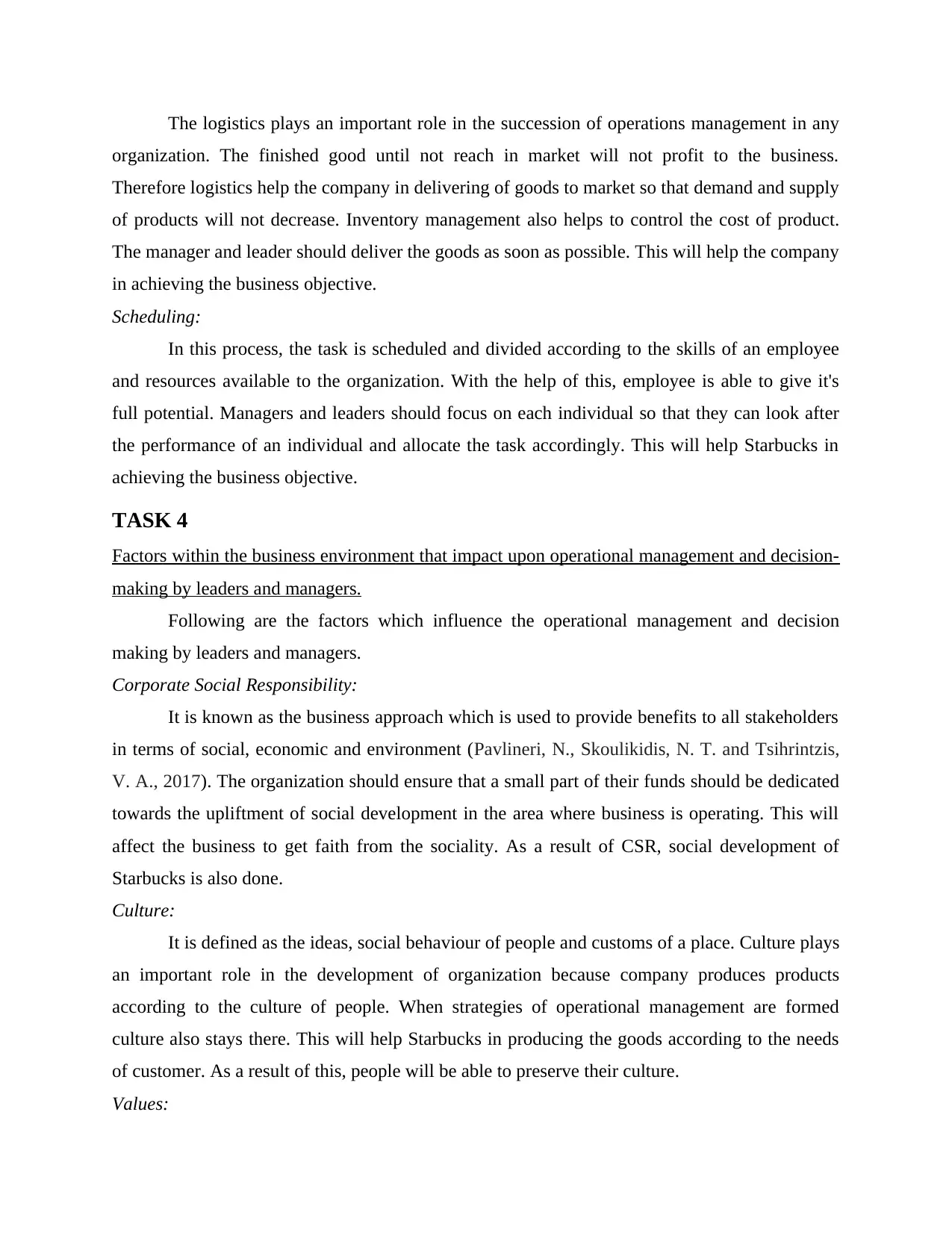
The logistics plays an important role in the succession of operations management in any
organization. The finished good until not reach in market will not profit to the business.
Therefore logistics help the company in delivering of goods to market so that demand and supply
of products will not decrease. Inventory management also helps to control the cost of product.
The manager and leader should deliver the goods as soon as possible. This will help the company
in achieving the business objective.
Scheduling:
In this process, the task is scheduled and divided according to the skills of an employee
and resources available to the organization. With the help of this, employee is able to give it's
full potential. Managers and leaders should focus on each individual so that they can look after
the performance of an individual and allocate the task accordingly. This will help Starbucks in
achieving the business objective.
TASK 4
Factors within the business environment that impact upon operational management and decision-
making by leaders and managers.
Following are the factors which influence the operational management and decision
making by leaders and managers.
Corporate Social Responsibility:
It is known as the business approach which is used to provide benefits to all stakeholders
in terms of social, economic and environment (Pavlineri, N., Skoulikidis, N. T. and Tsihrintzis,
V. A., 2017). The organization should ensure that a small part of their funds should be dedicated
towards the upliftment of social development in the area where business is operating. This will
affect the business to get faith from the sociality. As a result of CSR, social development of
Starbucks is also done.
Culture:
It is defined as the ideas, social behaviour of people and customs of a place. Culture plays
an important role in the development of organization because company produces products
according to the culture of people. When strategies of operational management are formed
culture also stays there. This will help Starbucks in producing the goods according to the needs
of customer. As a result of this, people will be able to preserve their culture.
Values:
organization. The finished good until not reach in market will not profit to the business.
Therefore logistics help the company in delivering of goods to market so that demand and supply
of products will not decrease. Inventory management also helps to control the cost of product.
The manager and leader should deliver the goods as soon as possible. This will help the company
in achieving the business objective.
Scheduling:
In this process, the task is scheduled and divided according to the skills of an employee
and resources available to the organization. With the help of this, employee is able to give it's
full potential. Managers and leaders should focus on each individual so that they can look after
the performance of an individual and allocate the task accordingly. This will help Starbucks in
achieving the business objective.
TASK 4
Factors within the business environment that impact upon operational management and decision-
making by leaders and managers.
Following are the factors which influence the operational management and decision
making by leaders and managers.
Corporate Social Responsibility:
It is known as the business approach which is used to provide benefits to all stakeholders
in terms of social, economic and environment (Pavlineri, N., Skoulikidis, N. T. and Tsihrintzis,
V. A., 2017). The organization should ensure that a small part of their funds should be dedicated
towards the upliftment of social development in the area where business is operating. This will
affect the business to get faith from the sociality. As a result of CSR, social development of
Starbucks is also done.
Culture:
It is defined as the ideas, social behaviour of people and customs of a place. Culture plays
an important role in the development of organization because company produces products
according to the culture of people. When strategies of operational management are formed
culture also stays there. This will help Starbucks in producing the goods according to the needs
of customer. As a result of this, people will be able to preserve their culture.
Values:
Paraphrase This Document
Need a fresh take? Get an instant paraphrase of this document with our AI Paraphraser
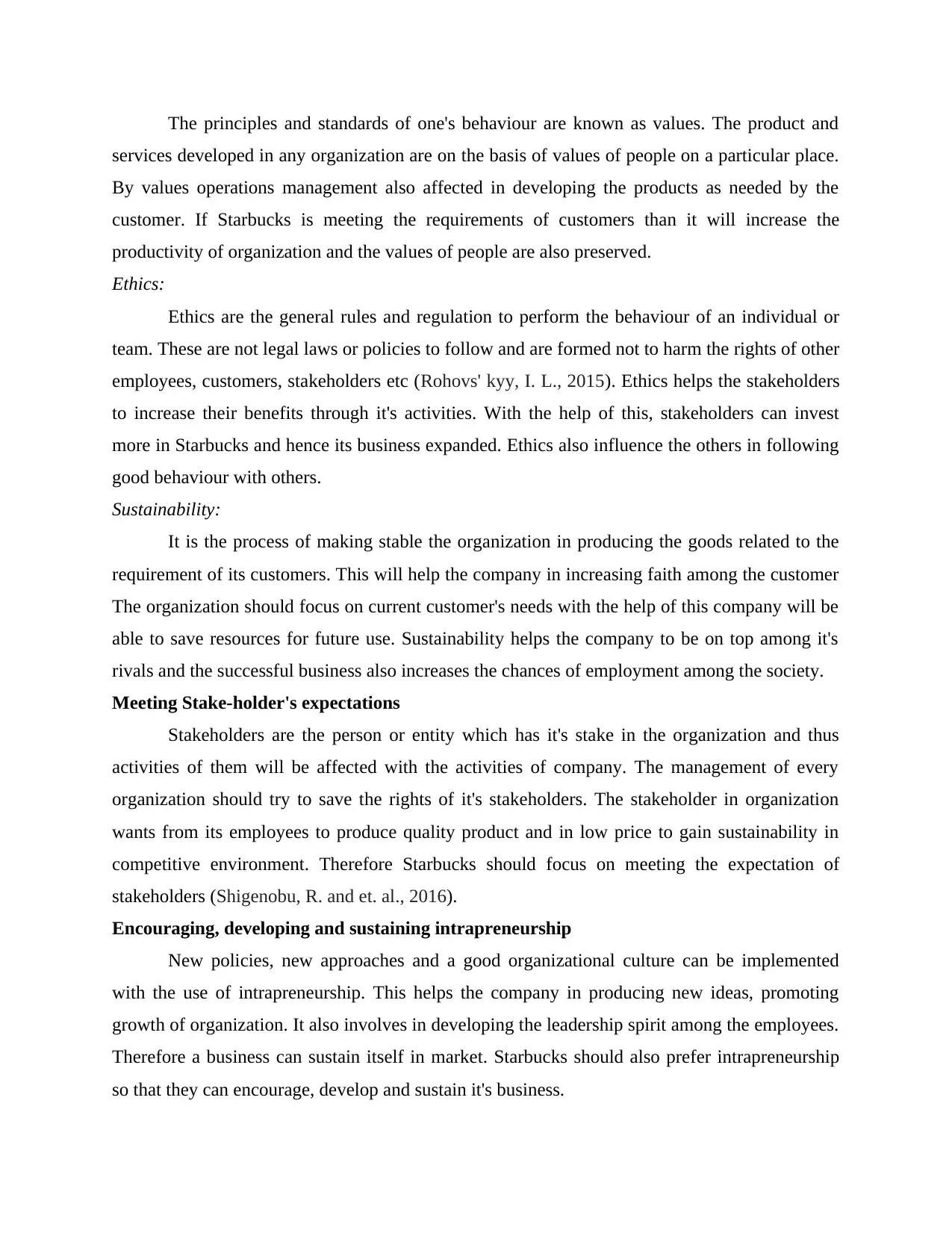
The principles and standards of one's behaviour are known as values. The product and
services developed in any organization are on the basis of values of people on a particular place.
By values operations management also affected in developing the products as needed by the
customer. If Starbucks is meeting the requirements of customers than it will increase the
productivity of organization and the values of people are also preserved.
Ethics:
Ethics are the general rules and regulation to perform the behaviour of an individual or
team. These are not legal laws or policies to follow and are formed not to harm the rights of other
employees, customers, stakeholders etc (Rohovs' kyy, I. L., 2015). Ethics helps the stakeholders
to increase their benefits through it's activities. With the help of this, stakeholders can invest
more in Starbucks and hence its business expanded. Ethics also influence the others in following
good behaviour with others.
Sustainability:
It is the process of making stable the organization in producing the goods related to the
requirement of its customers. This will help the company in increasing faith among the customer
The organization should focus on current customer's needs with the help of this company will be
able to save resources for future use. Sustainability helps the company to be on top among it's
rivals and the successful business also increases the chances of employment among the society.
Meeting Stake-holder's expectations
Stakeholders are the person or entity which has it's stake in the organization and thus
activities of them will be affected with the activities of company. The management of every
organization should try to save the rights of it's stakeholders. The stakeholder in organization
wants from its employees to produce quality product and in low price to gain sustainability in
competitive environment. Therefore Starbucks should focus on meeting the expectation of
stakeholders (Shigenobu, R. and et. al., 2016).
Encouraging, developing and sustaining intrapreneurship
New policies, new approaches and a good organizational culture can be implemented
with the use of intrapreneurship. This helps the company in producing new ideas, promoting
growth of organization. It also involves in developing the leadership spirit among the employees.
Therefore a business can sustain itself in market. Starbucks should also prefer intrapreneurship
so that they can encourage, develop and sustain it's business.
services developed in any organization are on the basis of values of people on a particular place.
By values operations management also affected in developing the products as needed by the
customer. If Starbucks is meeting the requirements of customers than it will increase the
productivity of organization and the values of people are also preserved.
Ethics:
Ethics are the general rules and regulation to perform the behaviour of an individual or
team. These are not legal laws or policies to follow and are formed not to harm the rights of other
employees, customers, stakeholders etc (Rohovs' kyy, I. L., 2015). Ethics helps the stakeholders
to increase their benefits through it's activities. With the help of this, stakeholders can invest
more in Starbucks and hence its business expanded. Ethics also influence the others in following
good behaviour with others.
Sustainability:
It is the process of making stable the organization in producing the goods related to the
requirement of its customers. This will help the company in increasing faith among the customer
The organization should focus on current customer's needs with the help of this company will be
able to save resources for future use. Sustainability helps the company to be on top among it's
rivals and the successful business also increases the chances of employment among the society.
Meeting Stake-holder's expectations
Stakeholders are the person or entity which has it's stake in the organization and thus
activities of them will be affected with the activities of company. The management of every
organization should try to save the rights of it's stakeholders. The stakeholder in organization
wants from its employees to produce quality product and in low price to gain sustainability in
competitive environment. Therefore Starbucks should focus on meeting the expectation of
stakeholders (Shigenobu, R. and et. al., 2016).
Encouraging, developing and sustaining intrapreneurship
New policies, new approaches and a good organizational culture can be implemented
with the use of intrapreneurship. This helps the company in producing new ideas, promoting
growth of organization. It also involves in developing the leadership spirit among the employees.
Therefore a business can sustain itself in market. Starbucks should also prefer intrapreneurship
so that they can encourage, develop and sustain it's business.
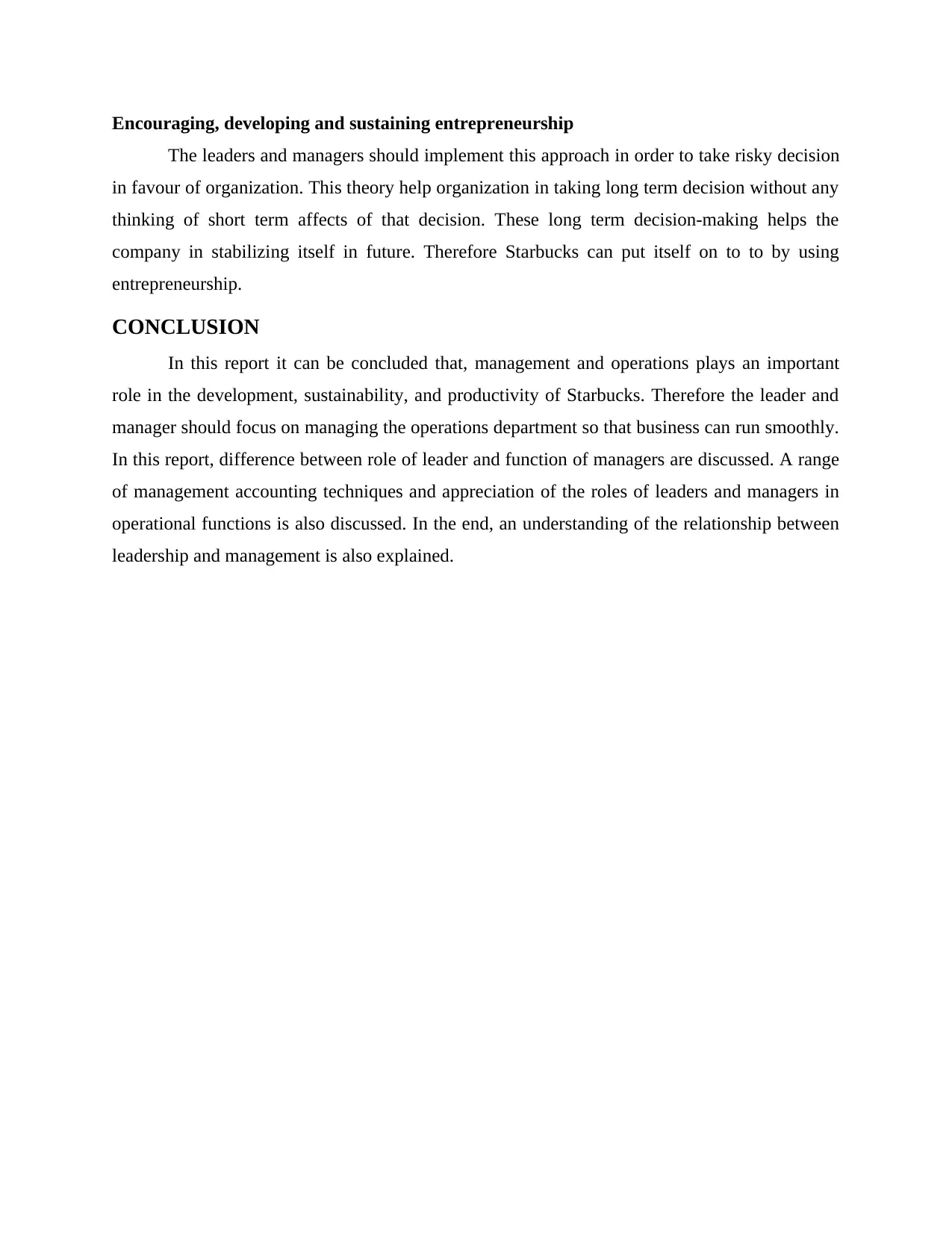
Encouraging, developing and sustaining entrepreneurship
The leaders and managers should implement this approach in order to take risky decision
in favour of organization. This theory help organization in taking long term decision without any
thinking of short term affects of that decision. These long term decision-making helps the
company in stabilizing itself in future. Therefore Starbucks can put itself on to to by using
entrepreneurship.
CONCLUSION
In this report it can be concluded that, management and operations plays an important
role in the development, sustainability, and productivity of Starbucks. Therefore the leader and
manager should focus on managing the operations department so that business can run smoothly.
In this report, difference between role of leader and function of managers are discussed. A range
of management accounting techniques and appreciation of the roles of leaders and managers in
operational functions is also discussed. In the end, an understanding of the relationship between
leadership and management is also explained.
The leaders and managers should implement this approach in order to take risky decision
in favour of organization. This theory help organization in taking long term decision without any
thinking of short term affects of that decision. These long term decision-making helps the
company in stabilizing itself in future. Therefore Starbucks can put itself on to to by using
entrepreneurship.
CONCLUSION
In this report it can be concluded that, management and operations plays an important
role in the development, sustainability, and productivity of Starbucks. Therefore the leader and
manager should focus on managing the operations department so that business can run smoothly.
In this report, difference between role of leader and function of managers are discussed. A range
of management accounting techniques and appreciation of the roles of leaders and managers in
operational functions is also discussed. In the end, an understanding of the relationship between
leadership and management is also explained.
⊘ This is a preview!⊘
Do you want full access?
Subscribe today to unlock all pages.

Trusted by 1+ million students worldwide
1 out of 13
Related Documents
Your All-in-One AI-Powered Toolkit for Academic Success.
+13062052269
info@desklib.com
Available 24*7 on WhatsApp / Email
![[object Object]](/_next/static/media/star-bottom.7253800d.svg)
Unlock your academic potential
Copyright © 2020–2025 A2Z Services. All Rights Reserved. Developed and managed by ZUCOL.





